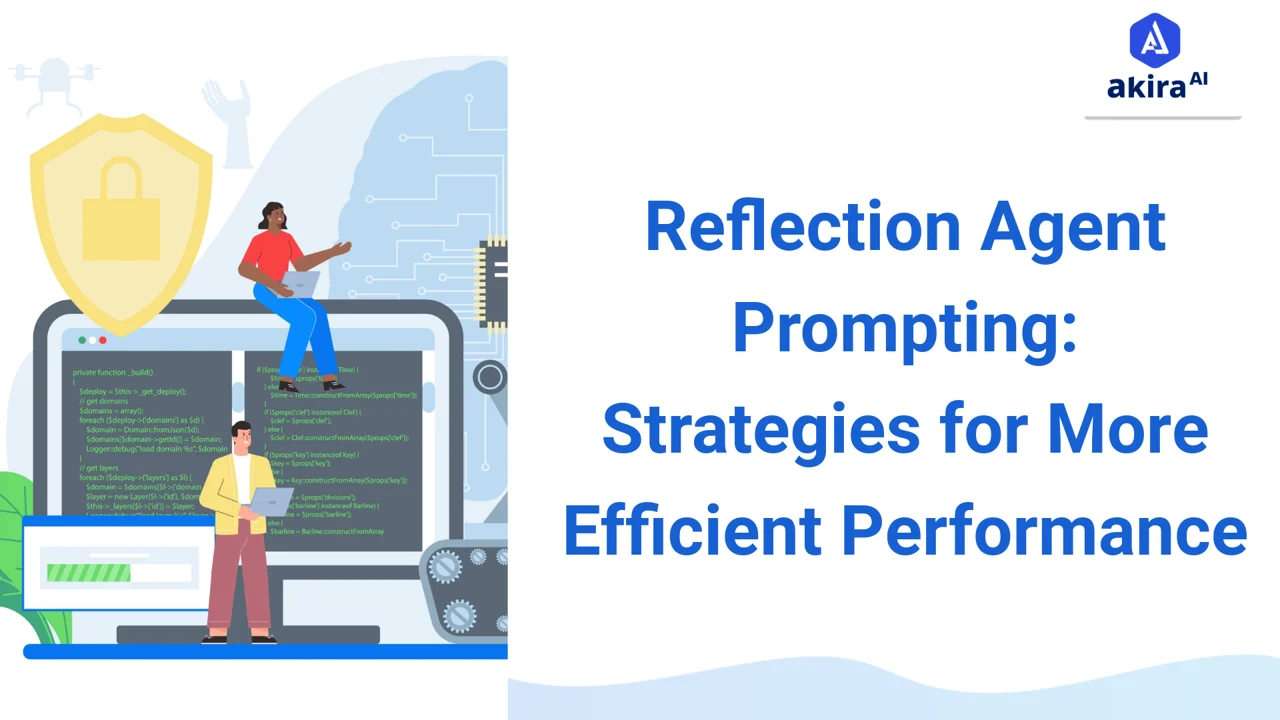Reflection agent prompting empowers AI systems to self-evaluate and refine their outputs through iterative feedback loops and memory mechanisms, enhancing decision-making and adaptability. While challenges like computational overhead and scalability exist, reflection is set to become a cornerstone in the development of more dynamic, generalized, and intelligent Agentic AI systems, paving the way for advanced problem-solving and adaptive learning.
What if AI could reflect on its own decisions to deliver smarter, more efficient results?Reflection agent prompting enables AI systems to assess their outputs and improve performance through self-evaluation and feedback loops. This approach allows AI agents to review their decisions, identify weaknesses, and refine their responses, making them more accurate and efficient over time.
By promoting iterative learning and continuous improvement, reflection agents enhance the overall quality of output, enabling more informed and adaptable decision-making. In this blog, we’ll explore how reflection agent prompting works, how it contributes to better performance, and why it’s becoming a key strategy for optimizing AI systems.
Background: Overview of Core Concepts
What is Reflection in AI Agents?
Reflection refers to the process whereby agents carefully review their decisions and outputs before presenting the outcome. This allows the agent to evaluate itself, recognize its weaknesses, and develop better output and decisions. This concept originates from human reflection; a human reflects on their actions and subsequently adjusts them according to improvement or self-criticism. In relation to the agents, this approach helps reduce mistakes and optimise output and task efficiency.
Reflection is used to understand how this strategy can assist AI agents in performing tasks more accurately and flexibly. Using an agent whose output is reflective before its delivery is most important when generating code, managing financial decisions, or producing complex manufacturing systems, among other things.
How Does Reflection Work in AI Agents?
Reflection in AI agents involves well-defined steps in how agents iteratively produce their outputs.
1. Set Up Initial Generation
Any agent task inherently comes with an output generation requirement at its very core. This stage usually consists of asking a question and triggering an agent to build a solution or response to the entered input. For example, in the code generation task, an agent can write a script that solves some programming problems.
Context Understanding: The agent should understand the context of the activity and what the workflow is achieving. If it was coding a snippet or some financial analysis, it should start with answers that fit the user’s expectations.
2. Add a Reflection Mechanism
Once the initial output is generated, reflection is triggered. This step focuses on evaluating the generated response for potential improvements. Reflection can be implemented through:
Self-Reflection Prompts: The agent shall undergo a strict self-appraisal by providing set reflection questions like, “Is the response accurate?” “Is there an even better way of doing this?” or “The logic in this output makes no sense.”
Secondary agent for Review: Another approach is to use another agent, the critic agent, to evaluate the output generated by the primary agent and suggest where enhancements may lie. This introduces additional scrutiny that guarantees the output has been critically analyzed.
3. Explicit Critique and Improvement
Reflexion is a technique that enables agents to provide a rationale for their actions and do so explicitly. This reflective reasoning allows the agent to review the process and output.
Decision Justification: Let us use the example of generating a code snippet. The agent may explain how certain structures are used or why code optimizes performance. This explicit critique allows the agent to improve the result and decision-making approach.
4. Memory Integration
Memory systems are frequently added to reflection agents to monitor their decisions and reflections across iterations.
Short-term Memory: This memory stores immediate feedback, enabling the agent to avoid repeating errors within a single task session. It can easily be integrated into chat memory.
Long-Term Memory: It accumulates knowledge over time, allowing the agent to improve over multiple interactions. We could use Redis to store and retrieve memory data for rich context-based responses.
5. Feedback Loop and Iteration
The agent’s output is fed back into the system to prompt reflection, which leads to an iterative improvement of the agent’s output. The agent then re-evaluates its initial output, recognizes if there is an issue or inefficiency, changes its initial output and re-learns through another reflection pass. The process goes on iteratively until the agent achieves a refined yet optimized result.
Repetition and Refinement: The feedback loop allows for multiple iterations of reflection, with refined output at each iteration. The agent builds up response over time until it delivers a final, polished response, but only after several rounds of self-assessment and refinement.
Architecture Diagram and Explanation of Reflection Agents Prompting
The architecture of a reflection-enabled AI system typically involves various primary components:
- Master Agent: The Master Agent is an orchestrator; it observes incoming requests, identifies relevant strategies, and merely serves as an orchestrator between Producer and Critic agents.
- Producer Agent: The Producer Agent is the central execution component that combines the capabilities of large language models with the rules-based processing functions, thereby producing the initial solutions. It produces the first iteration of any output requested.
- Reflection Agent: The Reflection Agent is an analytical component of the system. It uses a reflection engine and a knowledge graph to audit the producer’s output. It provides all-around analysis with recommendations for improvement and is based on well-established quality metrics. The output is finally produced when the quality meets the requirements; otherwise, it goes into a loop in which the producer agent modifies the user input until the input satisfies the predefined requirements.
- Memory Architecture: The system implements both short-term and long-term memory structures: Short-term memory retains the current context and most recent processing decisions. Long-term memory also holds historical trends and learned improvements.
Key Benefits of Reflection-Based Agents
- Error Reduction Reflection ability in AI agents is a major benefit because it can detect and correct errors before errors are a problem. These agents take that extra moment to review what they have already generated.
- Output Optimization: The more an AI agent thinks through its generated response, the better it becomes repeatedly. Such concentration on details makes the output useful and highly relevant.
- Adaptive Capability: The reflective capabilities make AI agents adapt perfectly to the requirements of every individual task, ensuring that the system stays effective and responsive.
- Long-term Learning: Memory-based learning is implemented over some time. When people develop thoughts, they reflect on and experience their experiences so that they do not make the same mistake again and again.
- Better Decision Making: It allows us to solve complex, multi-step problems much better. Smaller, tractable problems formed from the bigger problem break down this problem into easy reflections for the agents about what is going on at every step.
Use Cases of Reflection Agents Prompting
Reflection agents are of greatest utility in areas requiring extremely high precision and repeated refinement.
- Finance: In trading algorithms, reflection enhances the AI agents’ decision-making ability through improving the logic and strategy according to market feedback. Traders react more efficiently to market changes and make a better profit with less risk.
- Manufacturing: Agents can learn, in real-time, from inefficiencies through reflection and hence change the manufacturing production calendar and operational schedules. Example: During data analysis of a production line, the reflection-enabled AI agent may identify bottlenecks and suggest changes that enhance throughput.
- Health: Multi-agent systems for controlling medical equipment or schedules can use reflection, doing resource optimization and maintenance planning over tasks. For instance, AI agents may use reflection to decide when it would be best to perform maintenance on some critical equipment.
- Retail: The reflection agents can use customer behavior and sales data to improve inventory management and marketing strategies. Based on past sales trends, these agents can predict which products will be in demand and adjust stock levels accordingly.
Integration with Agentic AI
Reflection can be seamlessly integrated into AI platforms like Agentic AI by utilsing its modular architecture:
- Custom Reflection Criteria: Users can specify specific criteria for reflection about when and how it should be induced. For example, reflection may be triggered following important decision points or after attaining specific thresholds of performance. Agentic AI framework can be applied to create reflection prompts containing critical feedback loops for iteratively fine-tuning their reflections.
- User-Controlled Feedback: The process of reflection itself becomes observable and controllable by users through the use of monitoring tools like Langsmith.
- Dynamic learning. The nature of the learning mechanism ensures that Agentic AI is sensitive to the adopted reflection strategy in accordance with user interaction and outcomes. This means that, in real-time, the reflection criteria and procedures will be updated since the AI agent will receive feedback from the user regarding the quality of outputs.
Challenges and Limitations of Reflection Agents Prompting
- Computational Overhead: Processing of complex systems could be increased by reflection.
- Architecture Complexity: Adding reflection to existing systems may increase complexity, either in terms of providing more robust feedback or memory structures.
- Scalability: Complexity in tasks increases with each cycle of reflection and may be difficult to remain efficient.
- Over-Reflection: The agents may get locked in over-reflection loops which would delay the decisions.
- Feedback Bias: Inappropriate criteria of reflection would lead the agents to provide biased or partial feedback that would result in inferior outcomes.
Future Trends in Reflection for AI Agents
- Advanced Memory Systems: Future reflection agents will leverage more sophisticated memory mechanisms to track long-term learning across tasks.
- Context-Sensitive Reflection: The processes of reflection will be adaptive, depending on the task, and dynamically changed.
- Collaborative Agents: Multi-agent systems will use reflection to critique each other’s outputs. This will lead to enhancing collaborative in problem-solving.
- Dynamic Reflection Criteria: Future systems will allow reflection criteria to evolve, adapting to the complexity of tasks in real time.
- Generalized AI: Reflection is likely to play a foundational role in the development of more generalized AI systems that can handle a broader range of tasks.
Conclusion: AI Agents for Reflection Prompting
Reflection agent prompting is a powerful method for enhancing the performance of AI agents. By integrating feedback loops, memory systems, and explicit self-critique, reflection agents continuously refine their outputs and improve their task performance. This iterative process leads to more accurate, efficient, and adaptable AI systems, making them invaluable in industries ranging from finance to healthcare. As AI continues to evolve, reflection will remain a critical component of intelligent system design.



